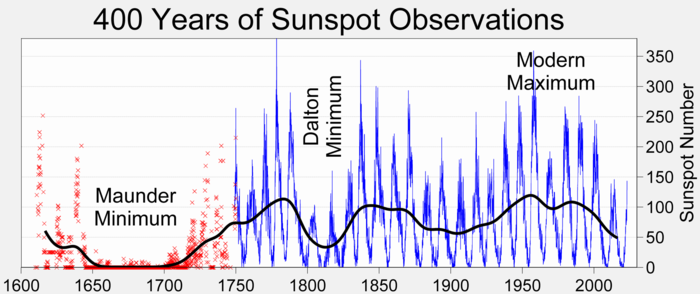According to NASA:
The current predicted and observed size makes this the smallest sunspot cycle since Cycle 14 which had a maximum of 64.2 in February of 1906.You can see how this stacks up against the record for the past 400 years.
According to an article in The Mail:
The Sun's activity is at its lowest for 100 years, scientists have warned.The article also states:
They say the conditions are eerily similar to those before the Maunder Minimum, a time in 1645 when a mini ice age hit, Freezing London's River Thames.
Researcher believe the solar lull could cause major changes, and say there is a 20% chance it could lead to 'major changes' in temperatures.
Mike Lockwood University of Reading says that the lower temperatures could affect the global jetstream, causing weather systems to collapse.
'We estimate within 40 years there a 10-20% probability we will be back in Maunder Minimum territory,' he said.
MY TAKE ON THIS DATA
Prediction is very difficult, especially if it's about the future.Lets say that these predictions come true, and the sun provides less energy to the earth for a period of decades. Temperatures would then be likely to trend lower. Climate change deniers would claim they had been right all the time, and concern for global warming would be likely to be less intense than it might have been. To counteract cold winters, more energy would be used in heating.
Niels Bohr
Perhaps these trends would lead to increased rates of greenhouse gas emissions. The level of Carbon Dioxide might increase in the atmosphere faster than would have otherwise occurred. When the sun's cycle returns to the more normal level, the problem of global warming may be exacerbated.
Who knows?


No comments:
Post a Comment